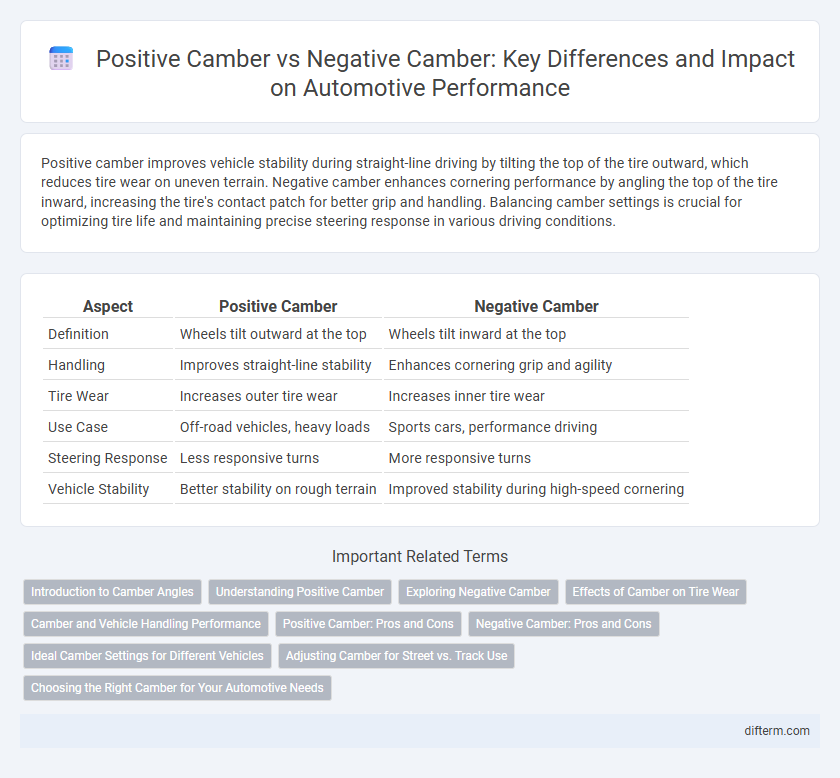Positive camber improves vehicle stability during straight-line driving by tilting the top of the tire outward, which reduces tire wear on uneven terrain. Negative camber enhances cornering performance by angling the top of the tire inward, increasing the tire's contact patch for better grip and handling. Balancing camber settings is crucial for optimizing tire life and maintaining precise steering response in various driving conditions.
Table of Comparison
| Aspect | Positive Camber | Negative Camber |
|---|---|---|
| Definition | Wheels tilt outward at the top | Wheels tilt inward at the top |
| Handling | Improves straight-line stability | Enhances cornering grip and agility |
| Tire Wear | Increases outer tire wear | Increases inner tire wear |
| Use Case | Off-road vehicles, heavy loads | Sports cars, performance driving |
| Steering Response | Less responsive turns | More responsive turns |
| Vehicle Stability | Better stability on rough terrain | Improved stability during high-speed cornering |
Introduction to Camber Angles
Camber angles refer to the tilt of a vehicle's wheels relative to the vertical axis when viewed from the front or rear. Positive camber means the top of the wheels tilt outward, enhancing stability and reducing tire wear on straight roads, while negative camber tilts the tops inward, improving cornering grip and handling performance. Understanding the balance between positive and negative camber is crucial for optimizing tire contact, vehicle dynamics, and overall driving safety.
Understanding Positive Camber
Positive camber refers to the outward tilt of a vehicle's wheels at the top, improving stability and steering ease during straight-line driving. This alignment reduces tire wear on the inner edges and enhances handling on rough or uneven terrain. Positive camber is commonly used in off-road and heavy-duty vehicles where durability and smooth performance are prioritized.
Exploring Negative Camber
Negative camber improves cornering performance by increasing tire contact with the road during turns, enhancing grip and stability. This setup is commonly used in racing and high-performance vehicles to reduce understeer and improve handling dynamics. Excessive negative camber can lead to uneven tire wear, so careful alignment adjustments are necessary to balance performance and tire longevity.
Effects of Camber on Tire Wear
Positive camber causes the outer edge of the tire to wear more quickly due to increased contact pressure, while negative camber leads to accelerated wear on the inner edge of the tire. Proper camber adjustment optimizes tire footprint, enhancing grip and extending tire life by distributing load evenly across the tread. Excessive camber, whether positive or negative, results in uneven tire wear, necessitating frequent replacements and reducing overall vehicle performance.
Camber and Vehicle Handling Performance
Camber angle significantly influences vehicle handling performance by affecting tire contact with the road surface. Positive camber, where the top of the tire tilts outward, enhances straight-line stability but reduces cornering grip, making it ideal for off-road or heavy vehicles. Negative camber, with the top of the tire tilting inward, improves lateral grip and cornering performance by maximizing tire contact during turns, commonly preferred in performance and racing vehicles.
Positive Camber: Pros and Cons
Positive camber increases tire stability during straight-line driving by tilting the top of the wheels outward, which improves load distribution on the outer edges of the tires. It enhances steering responsiveness and reduces tire wear on the inside edges, making it suitable for heavy vehicles and off-road conditions. However, positive camber can reduce cornering performance and cause understeer due to less tire contact during turns.
Negative Camber: Pros and Cons
Negative camber improves cornering grip by increasing the tire's contact patch during turns, enhancing vehicle stability and handling performance. It can, however, lead to uneven tire wear, particularly on the inner edges, reducing tire lifespan and increasing maintenance costs. Proper alignment and suspension tuning are essential to balance the benefits of negative camber with its potential drawbacks in automotive applications.
Ideal Camber Settings for Different Vehicles
Positive camber is ideal for vehicles requiring enhanced stability during straight-line driving, such as trucks and off-road SUVs, as it improves tire contact on uneven surfaces. Negative camber benefits sports cars and performance vehicles by increasing cornering grip and reducing tire wear during aggressive turns. Optimal camber settings depend on vehicle type, driving conditions, and intended use, balancing tire wear, handling, and stability for maximum performance.
Adjusting Camber for Street vs. Track Use
Adjusting camber angles directly affects tire contact and vehicle performance; positive camber, where the top of the tire leans outward, offers better stability and even tire wear for street driving, enhancing comfort and longevity. Negative camber, with the top of the tire leaning inward, improves cornering grip and handling on the track by maximizing tire contact during aggressive turns but may accelerate tire wear on regular roads. Optimizing camber settings depends on usage priorities: mild positive or neutral camber favors daily driving, while increased negative camber benefits high-performance track applications.
Choosing the Right Camber for Your Automotive Needs
Positive camber improves tire stability and steering response during straight-line driving, making it ideal for off-road vehicles and heavy trucks. Negative camber enhances cornering grip and handling performance by increasing tire contact patch during turns, preferred in sports cars and performance vehicles. Selecting the right camber angle depends on your driving style, vehicle type, and intended road conditions to optimize tire wear and overall vehicle control.
positive camber vs negative camber Infographic

 difterm.com
difterm.com